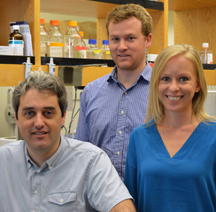Team Uses CRISPR to Hit Hibernating HIV
By Elie Diner
HIV is especially difficult to eliminate because it can hibernate in infected patients, eluding current antiretroviral drug therapy.
Researchers at The Scripps Research Institute (TSRI) have now developed a new method to switch on, or reactivate, hibernating viruses and force them out of hiding. The breakthrough uses the CRISPR/Cas9 system, a genetic engineering tool that can be easily programmed, to target HIV and advance a potential cure.
“Cas9 has been transformative for biology and in using it we’ve found a more specific and potent way of activating HIV,” said Kevin Morris, associate professor at TSRI and the University of New South Wales.
Morris was a senior author on the study, published recently in Molecular Therapy, with Marc Weinberg, adjunct assistant professor of molecular and experimental medicine at TSRI and professor of molecular medicine and haematology at the University of the Witwatersrand in Johannesburg, South Africa.
Draining the HIV Reservoir
HIV infections are currently treated with a combination of antiretroviral therapies (cART) that inhibit different stages in the viral life cycle. Use of these drugs has led to a large reduction in the morbidity, mortality and transmission associated with having HIV.
However, cART is unable to target hibernating, or latent, HIV. Latency occurs when the viral genome integrates into the genome of an infected cell and enters an inactive state. In this state, there is a reduction in a cellular process called transcription, which is important for making HIV RNA, and no viral genes are produced.
Cells carrying integrated HIV genomes act as a “reservoir” that enables HIV to come out of latency at any time, begin transcription of the viral genome and produce active virus. Reactivation is poorly understood, but can force many patients to continue cART for the duration of their lives.
Several latency-reversing agents (LRAs) have been investigated to drive HIV out of hibernation by activating transcription of the HIV genome, yet many have nonspecific and unpredictable effects on cells, leading to a disruption of normal cell division or toxicity and making them unfavorable as therapeutics.
“We wanted to find a potential LRA that could be as effective as the current therapeutics, but more specific,” said Weinberg of the group’s effort. To do this, the team investigated the use of the “dead” Cas9 (dCas9) system, a variant of the popular CRISPR gene editing system. dCas9 can be programmed to activate transcription at almost any sequence by using small guide RNAs (sgRNAs) that match a given DNA sequences. In this case, the group directed dCas9 to a region of the HIV genome where transcription normally begins.
dCas9 Marks HIV ‘Hotspot’
Morris, Weinberg and colleagues designed and tested 23 sgRNAs and analyzed their ability with dCas9 to activate transcription in several cell culture models for latent HIV. They found that targeting a small 20-30 nucleotide window led to strong activation of transcription, about 20-fold better than any of the other sequences targeted.
The group went on to compare their dCas9 system to several LRAs, some of which have been investigated clinically. By targeting dCas9 to the “hotspot” region the researchers identified, they found that they could activate HIV better than many other methods.
In addition, the team found its dCas9 system could specifically activate HIV with few off-target effects.
As with this and other Cas9 therapies, the process of moving this proof-of-concept treatment into the clinic is in its infancy. “The million-dollar question with any of these types of approaches is the cellular delivery, and there are a lot of options for the use of CRISPR that should be looked at when applying these technologies,” said Weinberg.
In addition to Weinberg and Morris, authors of the study, “Potent and Targeted Activation of Latent HIV-1 Using the CRISPR/dCas9 Activator Complex,” were co-first authors Sheena M. Saayman and Daniel C. Lazar, and Jonathan R. Hart of TSRI; Tristan A. Scott of the University of the Witwatersrand; Mayumi Takahashi and John C. Burnett of the Beckman Research Institute at the City of Hope; and Vicente Planelles of the University of Utah School of Medicine.
The research was supported by the Strategic Health Innovation Partnerships Unit of South African Medical Research Council with funds received from the South African Medical Research Council, the National Institutes of Health (grants P01 AI099783-01, R01 AI111139-01 and R01 DK104681-01) and the Australian Research Council.
Send comments to: press[at]scripps.edu















